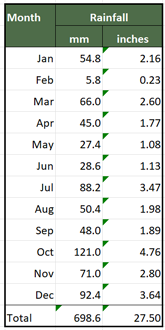Tuesday was another changeable day as far as the weather went. Early Tuesday afternoon on the plot was sunny, calm and warm but suddenly from nowhere came some dark clouds; a gale force wind sprung up and the temperature fell quickly by about 10°C.
Looking east it looked like a lovely summer afternoon but turn around and look west and it was a different story.
If you remember at the end of May I resowed some carrots due to lots of the first batch of seedlings being eaten by slugs. At the same time it became obvious that lots of our parsnips either hadn’t germinated or they had suffered the same fate as the carrot seedlings. As parsnip seeds are notoriously slow and difficult to germinate I thought we’d just cut our loses and settle for just the few parsnips that had survived.
I've read and watched videos on Youtube of the various techniques people have tried to get round the difficult germination issues. I've never succeeded in germinating parsnips in seed trays or modules and then planting them out. The parsnip top has grown well enough but it has not produced a parsnip root only a mangle of tiny white roots. Sue found a video of parsnips been sown on damp kitchen paper and then transplanted. We decided to give it a go as we’d have nothing much to loose.
The seeds were sown in a half sized seed tray on several layer of damp kitchen roll before being put in a polythene bag and placed in a warm dark room to germinate. Well the darkness was created by covering the tray with an old magazine.
The seeds have been examined each morning for any signs of germination taking place. I must be honest after a week of no signs of life at all I was beginning to think perhaps we had a duff batch of seed. I expected to see the seed swelling at the very least. Then after nine days there were the tiniest signs of life from some of the seeds.
By no means have all the seeds germinated but a decent number have. It looks like we're going to have to give some consideration to how we plant these very delicate little seedlings into the plot.
To transplant the sproutlings into the existing parsnip row I made a little hole in the compost, suitably spaced between already germinated seedlings and popped a seed in. I carefully covered it over with a little compost. The process wasn't as fiddly as I thought it was going to be. The seeds didn't stick to the kitchen paper although they did stick to my fingers a little. They were much tougher than I had expected them to be. I didn't have enough germinated seeds to do all our rows of parsnips but two rows are completed and the left over seeds are being left on the damp kitchen paper to see if any more germinate. They can then be added to some other rows to complement the existing parsnip seedlings.
It will be interesting to see if these pre germinated seeds grow and then if they do to see if they produce good useable roots. Now I have to be honest I haven’t got a method sorted out to tell the difference between parsnips planted traditionally and my pre-germinated experimental ones. I'm hoping we'll only have good roots and none of those funny stunted things I normally get when I transplant parsnips.





























I've found that parsnips which have been started off in loo rolls and then planted out are all shoulder and no root. I've pre germinated them previously but then sowed them in to loo rolls so I can't say whether planting them out as soon as they've germinated will produce the same results, however, when Sue mentioned that you were pre germinating some, I thought I'd give it a go myself so I've got some sown on to kitchen roll at the moment just waiting for them to show signs of life. I'll put them straight out on to the plot then. Even if they only go on to produce shoulders, it will be more than I'll get otherwise.
ReplyDeleteLots of people post that they get good results when they transplant parsnips. I don't know what I do wrong!
DeleteI'll be interested to see how they get on. Seeds always amaze me when they survive out in the ground, it always seems so improbable.
ReplyDelete